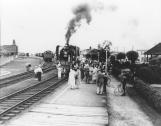15
Beginning in 1934 and 1935 the local economy began looking up with the arrival of the Dionne Quintuplets which drew a total of 37,500 tourists from all over North America between June and September 1935. Many traveled by train and filled the area's hotels.By 1935 both the C.P.R. and the C.N.R. were back to putting money into the community hiring a total of 269 North Bay men.
18
Peter Handly-Do you remember when the Dionnes were born and any changes that might have made that you could remember?Harlan Plue: Yes, I remember that well and it sort of put this region on the map I guess people never heard of North Bay or anything ……..put it right on the map that's all
Peter Handly-Did you believe it when you first read the newspaper?
Harlan Plue: Well, yes, yes what we were surprised that they lived, nobody expected that they were gonna live
Peter Handly-How did you feel with all the publicity that came up with all sorts of people all of a sudden coming to North Bay, was that a good thing for you?
Harlan Plue: Well, it didn't mean anything to me, no, cause it didn't concern me very much, my work on the railroad I wasn't concern about that
Peter Handly-But it must of made a difference when you were in town and you were sort of not working and there would be more people in town and all that sort of thing, I guess?
Harlan Plue: Yeah, well there was a lot, it increased our tourist trade, right away you know, we had tourists that came to North Bay, whether they seen the Quints or not they wanted to be, they could see where they were born anyway
Peter Handly-Did you see them yourself, did you go to see them?
Harlan Plue: Oh yes, I've seen them, yes I watch them growing up practically
19
Algonquin Regiment, 'B' Company leaving North Bay for Camp Borden, 19411941
North Bay, Ontario, Canada

20
The start of the Second World War in 1939 changed the emphasis of Canada's rail industry. The movement of troops and materials for the war effort dominated the rails.21
Temiscaming and Northern Ontario ticket to Montreal, circa 1941 to 19461940
North Bay, Ontario, Canada

24
Perhaps the biggest change in the rail industry came about with the transition from steam to diesel.The transition began in 1948-1949 for the C.P.R. when they first introduced diesel locomotives into service. By 1954 about one- third of the C.P.R.'s freight and passenger trains were diesel and by 1960 the transition was complete. The last steam C.P.R. locomotive to run was in 1960 with a 1887 4-4-0 on a special run from Montreal to St. Lin.
The C.N.R. went through the transition at the same time as the C.P.R. with the exception of of the No. 6218 that they ran until 1971.
The Ontario Northland (O.N.R.), formerly the
T.& N.O., made the transition with the last steam run in June 1957.





